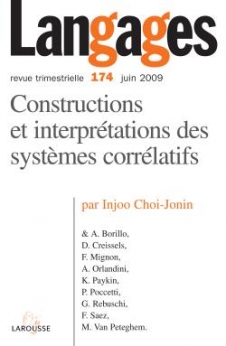
Langages n° 174 (2/2009)
Pour acheter ce numéro, contactez-nous
Recevez les numéros de l'année en cours et accédez à l'intégralité des articles en ligne.
Je voudrais montrer comment une situation de communication orale, qui détermine par elle-même un type de discours dans lequel un rôle important est donné aux énoncés de type interactif, est susceptible de privilégier certains modes d’expression qui s’adaptent aux conditions de son énonciation et de sa mise en fonctionnement. Les structures que je présenterai ici relèvent de la corrélation de type hypothétique dont la configuration la plus courante en français est celle d’un énoncé à deux termes : le premier figurant dans la protase, P, rend compte de ou sous-tend une hypothèse p, qui trouve dans le deuxième, l’apodose, Q, l’expression de la conclusion ou de la conséquence q, censée découler de son éventuelle réalisation ou non-réalisation.
Some kinds of hypothetical correlative structures are quite naturally associated with situations of spoken dialogs as they share a number of specific features characteristic of this kind of spoken discourse : 1) the fact that speaker and addressee interplay directly in discursive exchanges, 2) the fact that the correlative relation between the hypothesis emerging from P and the consequence contained in Q is expressed through grammatical constructions and enunciative devices based on modal constituents, speech acts, imperative structures, etc., 3) the fact that the correlative sequence must show a definite prosodic pattern (a suspensive pause on P preceding a falling intonation on Q). On the basis of these different factors, I will examine two main structure types, one with et ‘and’ representing the hypothesis si p inferred from P, the other with ou ‘or’ bringing about the hypothesis issued from P but endowed with the opposite value.

